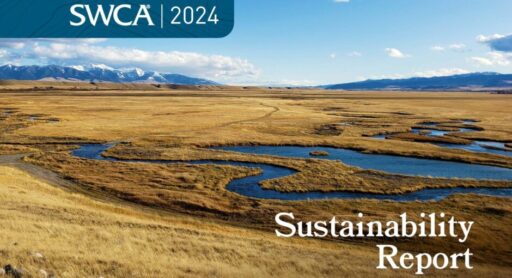2025
Comparably’s Best Company Outlook
* Providing engineering services in these locations through SWCA Environmental Consulting & Engineering, Inc., an affiliate of SWCA.

From the experts we hire, to the clients we partner with, our greatest opportunity for success lies in our ability to bring the best team together for every project.
That’s why:

At SWCA, sustainability means balancing humanity’s social, economic, and environmental needs to provide a healthy planet for future generations.

SWCA employs smart, talented, problem-solvers dedicated to our purpose of preserving natural and cultural resources for tomorrow while enabling projects that benefit people today.

At SWCA, you’re not just an employee. You’re an owner. Everyone you work with has a stake in your success, so your hard work pays off – for the clients, for the company, and for your retirement goals.
Chevron Deference: How the Supreme Court's Decision Impacts Environmental Compliance
On June 28, 2024, the Supreme Court issued a landmark decision in Loper Bright Enterprises et al. v. Raimondo, Secretary of Commerce, et al., fundamentally altering the landscape of administrative deference in the United States.
Ross is a respected expert in infrastructure permitting with a decade of experience in project, program, and policy development, management, and implementation. His primary focus has been on streamlining and enhancing the transparency of permitting decisions across federal, state, tribal, and local governments while prioritizing public input and environmental resources.

Jon is the Vice President of Scientific and Technical Services, responsible for advancing SWCA’s scientific and technical strategy, staff development, large project execution, and client development.



On June 28, 2024, the Supreme Court issued a landmark decision in Loper Bright Enterprises et al. v. Raimondo, Secretary of Commerce, et al., fundamentally altering the landscape of administrative deference in the United States. This decision overturns the long-standing Chevron deference doctrine, redefining the scope of judicial review over agency interpretations of ambiguous statutory provisions. It emphasizes the judiciary’s primary role in interpreting statutes, marking a significant shift in the balance of power between regulatory agencies and the courts. In this regulatory alert, we provide an overview of the decision’s possible implications for environmental permitting and regulatory compliance and how SWCA is ready to assist in navigating this new regulatory landscape.
Implications for Agency Rulemaking: Federal agencies may approach rulemaking with greater caution and precision. The ruling could compel agencies to ensure their regulations and interpretations are closely aligned with clear statutory authority to withstand judicial scrutiny. Agencies might also find it necessary to reevaluate existing regulations and interpretations to ensure they can be justified without relying on Chevron deference. This process could lead to revisions or clarifications of current rules to strengthen their legal standing.
Increased Judicial Scrutiny: Agencies’ regulatory interpretations could now face increased scrutiny from courts. In the near term, the decision could introduce more legal uncertainty as stakeholders test the boundaries of agency authority in the absence of Chevron deference. This environment may result in an increase in litigation as parties seek judicial clarification on regulatory interpretations.
Impact on Environmental Permitting: The enforcement and interpretation of environmental regulations, including those under the Clean Water Act, Endangered Species Act, National Environmental Policy Act, and National Historic Preservation Act, could be affected.
Strategic Considerations for Compliance: Entities engaged in activities subject to environmental regulation may need to reassess their regulatory compliance strategies to minimize uncertainty, anticipating changes in how agencies enforce and interpret regulations.
Changes in the Regulatory Landscape: Projects may experience changes in the regulatory landscape, affecting permitting processes and project timelines. In the short term, this uncertainty could create delays as agency staff and decision-makers evaluate the implications of their decisions. In the long term, there may be increased predictability in how regulations are applied, reducing the risk of shifts in regulatory interpretation based on changes in agency leadership or administrative-specific policy priorities.
At SWCA, we are poised to assist clients in understanding and adapting to the implications of the Supreme Court’s decision. Our team of policy experts, scientists, planners, and regulatory specialists can provide comprehensive support, including:
Regulatory Analysis: SWCA can provide in-depth analysis of current regulatory frameworks, helping you understand the implications of the recent Supreme Court decisions on your projects. By staying abreast of the latest regulatory changes, we ensure your projects are planned with the most current and comprehensive guidance in mind.
Stakeholder Engagement and Public Participation: The ruling could lead to enhanced transparency and accountability in the regulatory process, as agencies may be required to provide more comprehensive justifications for their actions by tying those actions directly to the statute. Public comments and stakeholder input could have a more direct influence on the development and implementation of regulations. Understanding the importance of stakeholder engagement and public participation in the project approval process, SWCA can guide you in developing and implementing effective engagement strategies.
Strategic Compliance Strategies: By proactively identifying potential regulatory changes and assisting our clients with their compliance strategies, SWCA can help ensure that projects not only meet current regulatory standards but are also positioned to efficiently adapt to future regulatory changes.
The Supreme Court’s decision to overturn Chevron deference represents a pivotal change in administrative law, with potentially significant implications for regulatory compliance and environmental permitting. As the legal and regulatory landscape evolves, SWCA remains committed to providing our clients with expert guidance and support to navigate these changes effectively.

Ross Pilotte, our strategic growth manager, spoke to Bloomberg about the implications of the recent Chevron ruling. He highlighted how the decision introduces ambiguity into the federal infrastructure permitting process, adding complexity for developers navigating agency regulations. As the legal and regulatory landscape evolves, SWCA remains committed to providing our clients with expert guidance and support to navigate these changes effectively. Read the full article here.